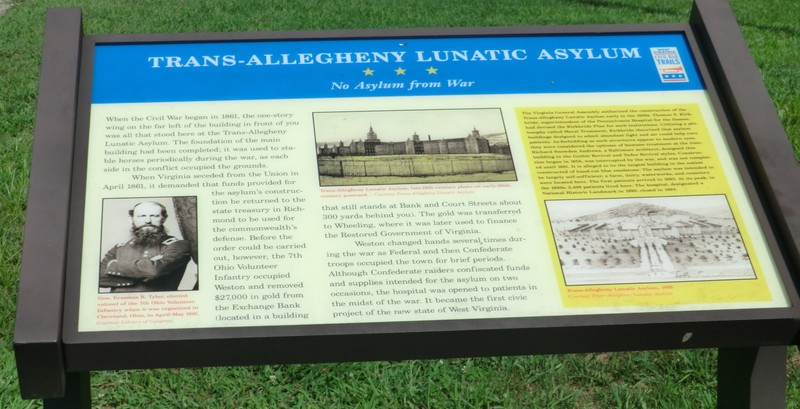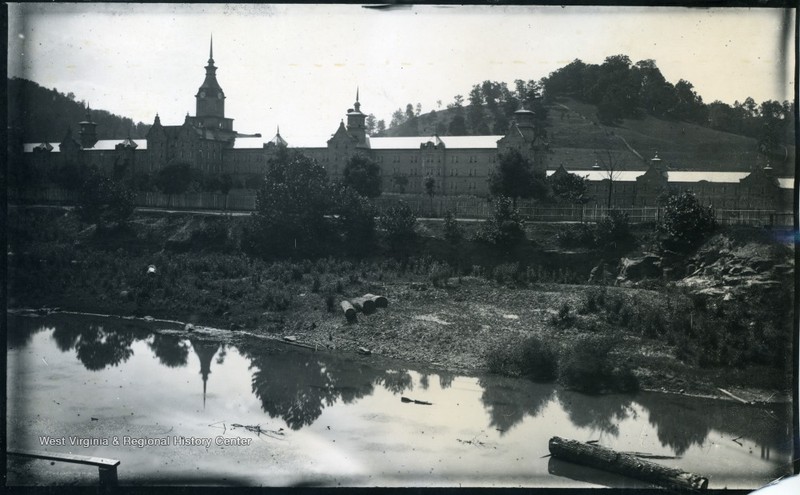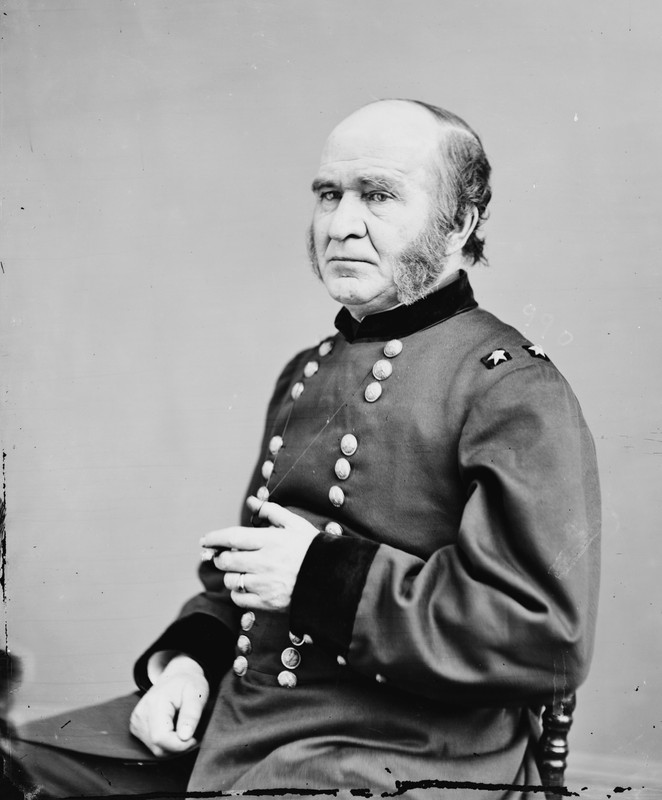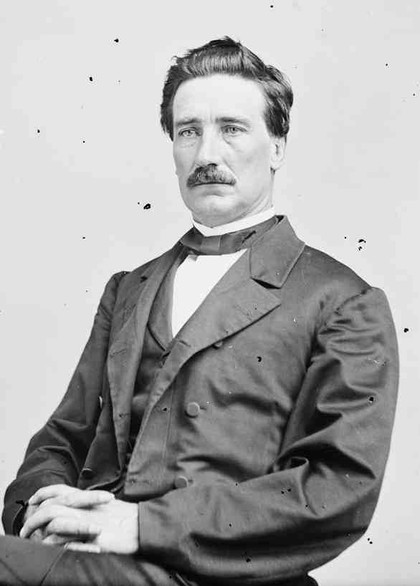Occupation of Weston during the Jones-Imboden Raid
Introduction
Text-to-speech Audio
Images
Historical marker regarding the asylum's role in the Civil War and Jones-Imboden Raid.

The Trans-Allegheny Lunatic Asylum in 1884, two decades after its occupation by General William E. Jones.

General Benjamin S. Roberts, Union commander during the Jones-Imboden Raid.

General John D. Imboden, Confederate commander the Jones-Imboden Raid.

General William E. Jones, Confederate commander during the Jones-Imboden Raid.

Backstory and Context
Text-to-speech Audio
Over the course of their invasion into what is now West Virginia, the Confederate forces under Generals William E. Jones and John D. Imboden had suffered a near continuous stream of losses due to a variety of factors. For Jones, the crossing of the South Potomac River on April 22 had forced him to leave behind his infantry and artillery while the skirmishes at Greenland Gap on April 25, Rowlesburg on April 26, Fairmont on April 29, and Bridgeport on April 30 had caused him an increasing number of casualties. Imboden, meanwhile, had insisted on including a number of units in his detachment recruited from the areas through which he intended to march, a choice that he believed would inspire further recruitment but instead led to a growing number of desertions as his soldiers escaped their camps to return to home. By the time the two Confederate forces reunited near Buckhannon on May 2, Imboden estimated his losses to desertion at nearly 200, while Jones’ command had been reduced by over a thousand by various causes.
After their reunion Jones and Imboden proceeded to the occupation of Weston the following day, where they intended to give their men some much needed rest while they weighed their options. Most of the pro-Union residents of the town had fled prior to the raiders’ arrival, leaving it in the hands of its Confederate sympathizers. Though the majority of Weston and Lewis County citizens had opposed Virginia’s secession from the Union in 1861, the number of Westonians that welcomed Jones’ and Imboden’s men to their community was substantial. Among this group was none other than Imboden’s own parents, whom the general convinced to evacuate with their belongings to seceded Virginia. His parents’ neighbors, meanwhile, presented the general with a handsewn Confederate flag as a token of their affection and offered as much aid as they thought able to give. Like many of their pro-secession compatriots in areas through which the rebels passed, however, the Confederate sympathizers of Weston soon found that their generosity was not enough to satisfy the needs of an ill-supplied army on the march. Jones’ and Imboden’s men soon alienated much of the local populace by forcing local merchants to accept payment for their wares in worthless Confederate money, requisitioning every horse and store of food in the area, and taking part in the occasional act of looting.
While their soldiers endeared themselves to the locals, Jones and Imboden discussed their options for the near future. Originally, their plan had been to confront the Federal troops under General Benjamin S. Roberts after reuniting at Buckhannon. When Roberts evacuated Buckhannon on April 27 and retreated to Clarksburg, Jones instead considered confronting him there after the rebel victory in Fairmont on April 29. Upon marching to within four miles of Clarksburg on April 30, however, Jones learned that Roberts might have had as many as 5,000 men under his command there after calling together almost all of the units he had earlier spread out in small outposts throughout the region. This intelligence had driven Jones to move instead on Bridgeport before proceeding to reunite with Imboden at Buckhannon on May 2. During their time in Weston from May 3 to May 6 a spy delivered reliable information to Imboden that confirmed the initial reports Jones had heard days earlier, forcing the Confederate commanders to conclude that their forces were inadequate to the task of confronting Roberts’ men.
The generals’ decision was cemented when Confederate troops were bloodied on scouting missions twice on consecutive days during their time in Weston. The first occasion, on May 4, pitted a detachment of the Nineteenth Virginia Cavalry under Captain John Sprigg against three companies of Federals along the road to Clarksburg. The second, the following day, forced several pickets posted near what is now Jane Lew, West Virginia to flee the seven miles back to Weston after being attacked by several detachments of cavalry, two infantry companies, and a section of artillery sent by Roberts to reconnoiter the area. The May 5 incident caused particular concern, since the pickets had upon their arrival to town stampeded down Main Street covered in blood. Certain that Roberts would soon advance from Clarksburg and believing Union troops were moving to regain control of the Staunton-Parkersburg Turnpike, Jones and Imboden concluded that their best option was to split their forces once more. While Jones moved to attack the oil fields at Burning Springs in Wirt County, thus depriving the Union of valuable fuel, Imboden would march to Summersville in Nicholas County to secure their retreat back to Confederate Virginia.
After the final exit of Confederate troops from Weston on May 6 Roberts moved quickly to reoccupy the town, claiming a great victory despite having largely failed to engage the enemy. With no rebels to threaten him, Roberts found the courage to arrest over sixty Confederate sympathizers in Weston for having supported Jones and Imboden during their stay there. The large bulk of these arrestees were forced to leave for rebel-held Virginia, while some were moved to Camp Chase in Columbus, Ohio, a common destination for the secessionists arrested by Federal authorities in what became West Virginia. Jones’ headquarters at the Trans-Allegheny Lunatic Asylum, meanwhile, went on to open for its intended purpose for the first time in 1864. Its occupation by Jones was just one phase in the contested history of its opening, which included a demand from the Confederate government of Virginia that the funds for its construction be returned to the state to finance the war effort and the later removal of those same funds to finance the establishment of the new state of West Virginia. With Weston firmly in Union hands after Jones’ and Imboden’s departure, however, affairs were calm enough in the town for the asylum to open. When it did, it held the unique status of being the new state’s first civic project.
Sources
Ballard, James Buchanan. William Edmondson "Grumble" Jones: the Life of a Cantankerous Confederate. Jefferson, NC: McFarland & Company, Inc., Publishers, 2017.
Collins, Darrell L. The Jones-Imboden Raid: the Confederate Attempt to Destroy the Baltimore & Ohio Railroad and Retake West Virginia. Jefferson, NC: McFarland & Co., 2007.
“Imboden's Expedition into West Virginia.” In United States Congressional Serial Set, 2766:90–106. Washington, D.C.: United States Government Printing Office, 1891.
“Jones' Raid on the Northwestern (Baltimore and Ohio) Railroad.” In United States Congressional Serial Set, 2766:107–37. Washington, D.C.: United States Government Printing Office, 1891.
Smith, Edward Conrad. A History of Lewis County, West Virginia. Weston, WV, 1920.
Tucker, Spencer. Brigadier General John D. Imboden: Confederate Commander in the Shenandoah. Lexington: University Press of Kentucky, 2003.
The Historical Marker Database
The West Virginia and Regional History Center
Wikipedia
Wikipedia
Wikipedia
